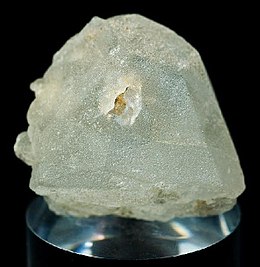| Pollucite | |
|---|---|
 Euhedral, tabular crystal of colorless, translucent and lustrous pollucite with frosted crystal faces from Afghanistan (size: 2.7 x 2.4 x 1.2 cm) | |
| General | |
| Category | Zeolite mineral |
| Formula (repeating unit) | Cs(Si2Al)O6·nH2O |
| IMA symbol | Pol[1] |
| Strunz classification | 9.GB.05 |
| Dana classification | 77.1.1.2 |
| Crystal system | Isometric |
| Crystal class | Hexoctahedral (m3m) H-M symbol: (4/m 3 2/m) |
| Space group | Ia3d |
| Unit cell | a = 13.67 Å; Z = 16 |
| Identification | |
| Color | Usually colorless; also white, grey, pink, blue or violet |
| Crystal habit | Usually massive; rare crystals are normally trapezohedral or cubic |
| Cleavage | None observed |
| Fracture | Conchoidal to uneven |
| Tenacity | Brittle |
| Mohs scale hardness | 6.5 to 7 |
| Luster | Vitreous to greasy |
| Streak | White |
| Diaphaneity | Transparent to translucent |
| Specific gravity | 2.7 to 3.0 |
| Optical properties | Isotropic or very weakly anisotropic |
| Refractive index | 1.508–1.528 |
| Solubility | Readily soluble in HF; dissolves with difficulty in hot HCl |
| Other characteristics | Sometimes weakly fluorescent under SW and LW UV |
| References | [2][3][4][5][6] |
Pollucite is a zeolite mineral with the formula (Cs,Na)2Al2Si4O12·2H2O with iron, calcium, rubidium and potassium as common substituting elements. It is important as a significant ore of caesium and sometimes rubidium. It forms a solid solution series with analcime. It crystallizes in the isometric-hexoctahedral crystal system as colorless, white, gray, or rarely pink and blue masses. Well-formed crystals are rare. It has a Mohs hardness of 6.5 and a specific gravity of 2.9, with a brittle fracture and no cleavage.
- ^ Warr, L.N. (2021). "IMA–CNMNC approved mineral symbols". Mineralogical Magazine. 85 (3): 291–320. Bibcode:2021MinM...85..291W. doi:10.1180/mgm.2021.43. S2CID 235729616.
- ^ Mineralienatlas
- ^ Gaines, et al. (1997) Dana's New Mineralogy, Wiley ISBN 978-0471193104
- ^ Pollucite on Mindat.org
- ^ Pollucite data on Webmineral
- ^ Handbook of Mineralogy